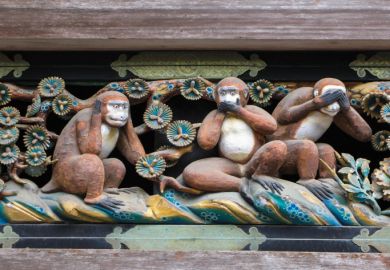This is a fat book from which a thin book ought to be trying to get out. The fat is all about people. The skeleton and vital organs are about institutions. Let me explain.
It is common knowledge in academia that until recently Oxford was far behind Cambridge in natural sciences. Now they are level-pegging. What happened in Oxford between the wars, when it was beginning to catch up?
The fat stuff is pretty indigestible and at times distinctly rancid. A few scientific and/or entrepreneurial geniuses made big waves in the oceans of knowledge and/or assembled miscellaneous resources and people into effective research schools. There were also quite a few eccentric deadbeats who clung to tenured posts long past their sell-by dates, and one scoundrel who went to prison and saddled the university with the risk of a vast financial loss in a court case. But mostly they were decent enough chaps - very few other-gendered, of course - whose worthy but unremarkable careers are dutifully chronicled. This being Oxford, the classes of their original undergraduate degrees are carefully noted, as well as the occasional FRS. Regret is expressed for those who went away and even made good as professors in other universities. Of those few who came from elsewhere as grown-up scientists, it is explained patiently how their personal accomplishments - good humour, a palate for wine, esoteric connoisseurship, and such like clubbable graces - fitted them well for Oxford life: or the contrary, as frequently happened. And so on, page after page.
Within this multi-biographical suet pudding there are some knobs of gossip and scandal. Too frequently, alas, a couple of worthy scholars are not on speaking terms, or are bent on undermining each other with characteristic bitterness. Jack Morrell reports these nasty episodes dryly and wryly, not dramatising them but making quite clear how unpleasant and damaging they were. At first I chortled at the bizarre goings-on, but the principal actors soon became a bit sickening in their childish, vain intransigence. It was a relief now and then to come across a happy little department, energised by a fair-minded and imaginative scientific leader who was respected and loved by his colleagues and students. In general, however, what a dump!
The point is, of course, that academic life everywhere is often like that in daily detail. William Cooper's marvellous novel The Struggles of Albert Woods caught the particular atmosphere of interwar Oxford science without all the tedious facts. But for historical understanding we need to look beneath the layers of fat for a thinner, sturdier narrative.
I visualise this as a slim volume in three institutional dimensions. Morrell gives a thorough account of the situation in the educational dimension. In brief, an entrenched doctrine of "liberal" education disdainfully repulsed all vocational challenges. Oxford was not just an "arts university". It had rationalised its historical academic heritage into a dogma that had no room for the sciences. In some cases, as with engineering and agriculture, this was just the conventional genteel prejudice against useful material labour. But the brush of utility tarred all the experimental and field sciences, except preclinical physiology and, for some mysterious reason, chemistry. It even extended to the queen of intellectual endeavours, pure mathematics, which had lost its throne by the Isis in the longue duree from the Middle Ages.
In the disciplinary dimension, where research is the real name of the game, Oxford is not presented here as an active player. Or, rather, the scientific developments that did take place in Oxford during that period - and they were indeed substantial - seem somehow disconnected from anything that was happening elsewhere. People enter and leave with labels attached to them - "organic chemist", "botanist", etc - but there is no sense of their being active members of the national and international "invisible colleges" of their respective subjects. Is this because Morrell underplays this dimension of his theme, or is this a reflection of Oxonian attitudes? Even in the thin book, this aspect needs enlarging.
Take geology, for example. Here was a great scientific discipline, strongly rooted in Victorian England and well institutionalised in the wider academic world. I would have thought that in Oxford it would already have built a stronghold, and not have had to struggle so hard to achieve a critical research and teaching mass. To understand what happened in Oxford in the 1920s and 1930s, we need to have an account of what had gone on there previously, and what was going on in other places during that same period. How did Oxford research figure in geology as an institution, in Britain and the world? Were its specialities considered by other geologists to be in the vanguard of science, or at least in the mainstream of current advance? It is not sufficient - though again characteristically Oxbrigensien - to make envious comparisons with the only "other place" that counted. Cambridge was certainly the biggest centre for academic science in Britain at that time, but what about London, or Manchester, or Harvard? This dimension is important, because pressures for change were transmitted along disciplinary channels, both by people outside Oxford who fancied working among its ivy-covered halls and by ambitious Oxonians seeking external recognition in their subject.
The third dimension is, of course, organised institutions. Morrell is informative on these, and especially in the way that their resources of money and men (again, literally) were deployed, sought and fought over. The university itself was weak, poor, and chaotically managed. All it seemed able to do was to hold the ropes for more robust protagonists. Outside Oxford there were a remarkable number of well-heeled bodies - government departments, research councils, philanthropic trusts and individuals - who were often surprisingly generous with funds. It is not clear whether they particularly favoured Oxbridge for its ambience and other heritage qualities, or whether they thought that surely such famous universities must be highly visible locations for their ventures. Nevertheless, they were often the only means of support for the people working in the various research units and institutes founded in Oxford in that period. Even though some of these - for example, the Breslau Low Temperature physicists who came as refugees from Nazism - were much more distinguished than the local lads, they lived precariously on "soft money" until Hitler's war.
So what about the richest and most powerful institutions in the whole set-up - the colleges? As usual in response to demands for academic change, they were unwelcoming and unhelpful, if not positively obstructive. They were miserly with funding for new fellowships and with their club facilities. Morrell does not go into all the effects of their stranglehold on student entry, early-tenured posts and access to university authority. Like most Oxonians even now, he shrugs his shoulders and accepts their story that the colleges are legally independent bodies that cannot be forced by the university to serve its collective purposes.
Lavish state patronage after the war postponed until this year a crisis on the Humpty-dumpty question of who will be master, but symptoms of the endemic malady of exclusive separatism show through the subcutaneous fat of this carefully researched book, and would be revealed brewing in the guts of its thinner version.
John Ziman is emeritus professor of physics, University of Bristol.
Science at Oxford, 1914-1939: Transforming an Arts University
Author - Jack Morrell
ISBN - 0 19 820657 7
Publisher - Oxford University Press
Price - £55.00
Pages - 473
Register to continue
Why register?
- Registration is free and only takes a moment
- Once registered, you can read 3 articles a month
- Sign up for our newsletter
Subscribe
Or subscribe for unlimited access to:
- Unlimited access to news, views, insights & reviews
- Digital editions
- Digital access to THE’s university and college rankings analysis
Already registered or a current subscriber? Login



